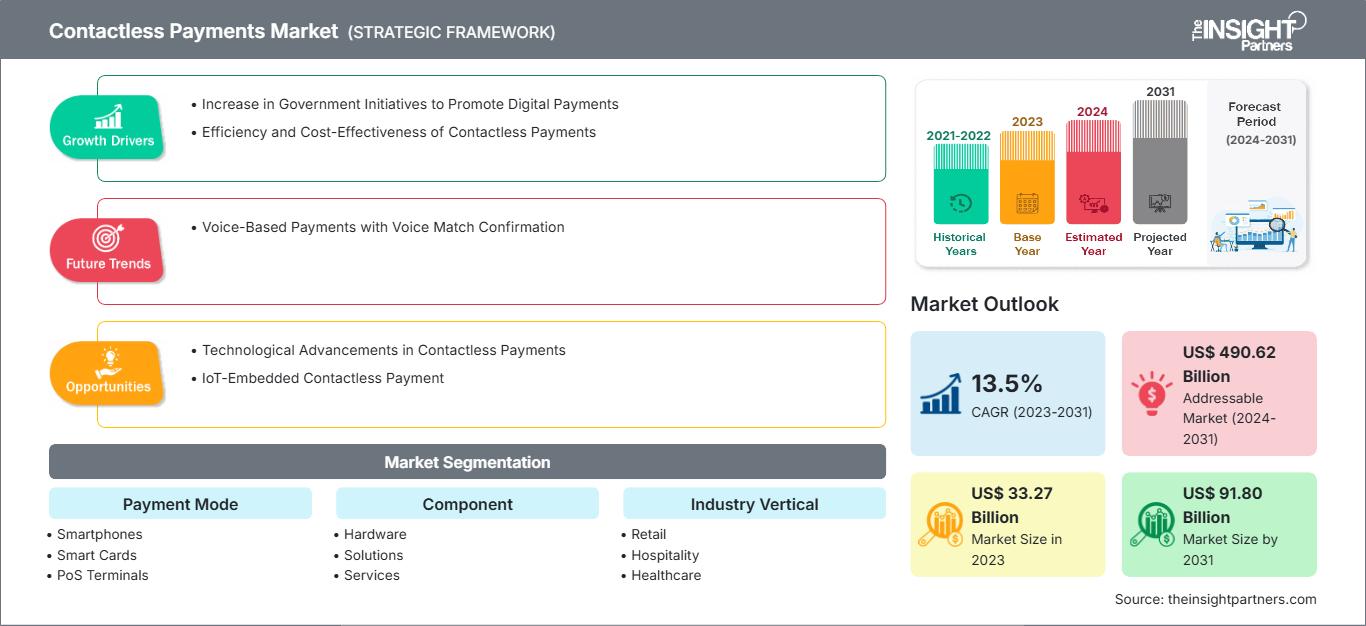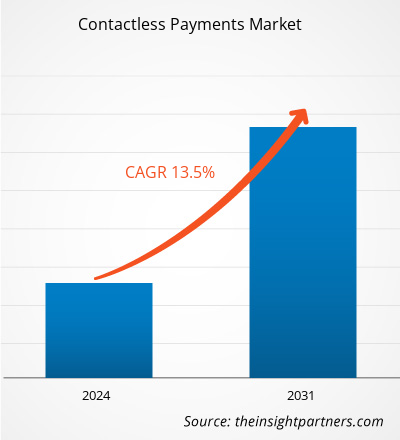Der Markt für kontaktlose Zahlungen soll von 33,27 Milliarden US-Dollar im Jahr 2023 auf 91,80 Milliarden US-Dollar im Jahr 2031 anwachsen. Für den Markt wird zwischen 2023 und 2031 ein durchschnittliches jährliches Wachstum von 13,5 % erwartet. Sprachbasierte Zahlungen mit Stimmbestätigung bleiben voraussichtlich ein wichtiger Markttrend.
Marktanalyse für kontaktlose Zahlungen
Weltweit fördern verschiedene Regierungen die Verwendung digitaler Zahlungen. Die Regierungen verschiedener Länder im asiatisch-pazifischen Raum fördern digitale Zahlungen und Finanztechnologien aktiv. Sie haben Richtlinien und Initiativen umgesetzt, um die Einführung kontaktloser Zahlungen zu fördern. Das IoT umfasst ein riesiges Netzwerk miteinander verbundener Geräte, die jeweils mit Sensoren und Software ausgestattet sind und Daten über das Internet sammeln und austauschen können. Tragbare Geräte wie Smartwatches, kontaktlose Zahlungskarten und mobile Apps mit IoT-Technologie ermöglichen es Benutzern, Zahlungen durch einfaches Antippen oder durch Halten ihres Geräts in die Nähe eines Point-of-Sale-Terminals (PoS) zu tätigen. Der Verzicht auf physische Karten oder Bargeld vereinfacht den Transaktionsprozess und minimiert das Verlust- oder Diebstahlrisiko. Sicherheitsbedenken stehen bei Finanztransaktionen seit langem im Mittelpunkt.
Marktübersicht für kontaktlose Zahlungen
Kontaktloses Bezahlen ist eine sichere und bequeme Möglichkeit, Waren und Dienstleistungen mit Smartphone, Debit- oder Kreditkarte zu bezahlen. Dabei kommen RFID-Technologie (Radio Frequency Identification) und NFC (Near Field Communication) zum Einsatz. Kontaktloses Bezahlen funktioniert durch Antippen oder Bewegen des Zahlungsgeräts über ein Kassenterminal mit kontaktloser Zahlungstechnologie. Kontaktloses Bezahlen bietet mehrere Vorteile, wie z. B. kürzere Transaktionszeiten und weniger Aufwand, da Kunden weder ihre PIN eingeben noch Bargeld an der Kasse handhaben müssen. Kontaktloses Bezahlen verbessert das Kundenerlebnis und das Vertrauen, da kontaktloses Bezahlen sicher und verschlüsselt ist, um betrügerische Käufe zu verhindern. Es bietet Flexibilität bei den Zahlungsgeräten, da Kunden mit ihrem NFC-fähigen Smartphone, Wearable oder ihrer kontaktlosen Karte bezahlen können. Es bietet Treuevorteile, da einige kontaktlose Zahlungssysteme in Treueprogramme integriert sind, die Kunden Rabatte und Prämien bieten.
Passen Sie diesen Bericht Ihren Anforderungen an
Sie erhalten kostenlos Anpassungen an jedem Bericht, einschließlich Teilen dieses Berichts oder einer Analyse auf Länderebene, eines Excel-Datenpakets sowie tolle Angebote und Rabatte für Start-ups und Universitäten.
Markt für kontaktlose Zahlungen: Strategische Einblicke

-
Holen Sie sich die wichtigsten Markttrends aus diesem Bericht.Dieses KOSTENLOSE Beispiel umfasst Datenanalysen, die von Markttrends bis hin zu Schätzungen und Prognosen reichen.
Markttreiber und -chancen für kontaktlose Zahlungen
Effizienz und Kosteneffizienz kontaktloser Zahlungen begünstigen den Markt
Kontaktlose Zahlungstechnologien ermöglichen Transaktionen über kontaktlose Chips, die in Zahlungskarten, Tags, Wearables und Mobiltelefone integriert sind. Kontaktlose Zahlungen ermöglichen schnelle Bankgenehmigungen, und das Geld wird sofort auf das Konto überwiesen. Dies reduziert Wartezeiten und Aufwand für Verbraucher und Händler und verbessert die Effizienz und den Komfort von Zahlungen. Kontaktlose Zahlungen ermöglichen die Automatisierung monatlicher Zahlungen, um Zeit und Aufwand zu sparen und Cashback zu erhalten. Außerdem fallen bei kontaktlosen Zahlungen niedrige Bearbeitungsgebühren an.
Technologische Fortschritte bei kontaktlosen Zahlungen
Für kontaktlose Zahlungen wird NFC verwendet. Das direkte Anhalten einer Chipkarte oder eines Smartphones an das Lesegerät bietet zusätzliche Sicherheit und macht kontaktlose Zahlungen sicher. NFC ist die Technologie, die von Smartphones verwendet wird, die mobile Geldbörsen wie ApplePay ermöglichen. Kontaktloses Bezahlen ermöglicht schnellere Transaktionen und eine höhere Kundenzufriedenheit und -treue sowie die Einführung neuer Zahlungstechnologien wie NFC und anderer, die die Kommunikation zwischen Maschinen und die IoT-Integration erleichtern.
Segmentierungsanalyse des Marktberichts zum kontaktlosen Bezahlen
Schlüsselsegmente, die zur Ableitung der Marktanalyse für kontaktloses Bezahlen beigetragen haben, sind Zahlungsart, Komponente und Branche.
- Basierend auf der Zahlungsart ist der Markt für kontaktloses Bezahlen in Smartphones, Smartcards, PoS-Terminals und andere unterteilt. Das Segment Smartphones hatte 2023 den größten Marktanteil. Beim kontaktlosen Bezahlen mit Smartphones wird ein mobiles Gerät, beispielsweise ein Smartphone, verwendet, um Kredit- und Debitkarteninformationen sicher zu speichern. Dadurch können Benutzer Einkäufe tätigen, indem sie ihr Gerät an ein kompatibles Kartenlesegerät halten, wodurch Bargeld oder das Durchziehen einer physischen Karte überflüssig wird.
- Nach Komponenten ist der Markt in Hardware, Lösungen und Dienstleistungen segmentiert. Das Hardwaresegment hatte 2023 den größten Marktanteil. Hardware für kontaktloses Bezahlen umfasst die physischen Geräte und Technologien, die für sichere Transaktionen verwendet werden, ohne dass physischer Kontakt zwischen dem Zahlungsgerät und dem Point-of-Sale-Terminal (POS) erforderlich ist.
- In Bezug auf die Branchen ist der Markt in Einzelhandel, Gastgewerbe, Gesundheitswesen, Transport und Logistik sowie Medien und Unterhaltung und andere unterteilt. Das Einzelhandelssegment hatte 2023 einen bedeutenden Marktanteil. Kontaktloses Bezahlen im Einzelhandel bezieht sich auf eine sichere und bequeme Zahlungsmethode, die es Kunden ermöglicht, Transaktionen durchzuführen, indem sie eine Zahlungskarte oder ein anderes Gerät in die Nähe eines mit kontaktloser Zahlungstechnologie ausgestatteten Point-of-Sale-Terminals halten.
Marktanteilsanalyse für kontaktloses Bezahlen nach Geografie
Der geografische Umfang des Marktberichts für kontaktloses Bezahlen ist hauptsächlich in fünf Regionen unterteilt: Nordamerika, Asien-Pazifik, Europa, Naher Osten und Afrika sowie Süd- und Mittelamerika.
Kontaktloses Bezahlen erfreut sich in den USA bereits zunehmender Beliebtheit. Die COVID-19-Pandemie hat die Nutzung verschiedener berührungsloser Zahlungsmethoden unter Amerikanern deutlich gesteigert. Wie aus der Mastercard Contactless Consumer Polling hervorgeht, nutzten im November 2023 mehr als die Hälfte (51 %) der Amerikaner irgendeine Form kontaktloser Zahlung, wie etwa Tap-to-go-Kreditkarten und mobile Geldbörsen wie Apple Pay. Die steigende Beliebtheit kontaktloser Zahlungen ist zumindest teilweise auf die wachsenden Bedenken hinsichtlich der Hygiene beim Unterschreiben am Point of Sale (PoS) oder bei der Verwendung von Bargeld zurückzuführen. Der Umfrage zufolge haben 50 % der US-Verbraucher Bedenken hinsichtlich der Sauberkeit von Unterschriften-Touchpads, und 72 % der US-Verbraucher verzichten ganz auf Unterschriften.
Die Europäische Zentralbank (EZB) überwacht den Zahlungsmarkt im Euroraum, um den reibungslosen Betrieb der Zahlungssysteme und die Verfügbarkeit verschiedener Zahlungsmethoden sicherzustellen. Durch die Analyse von Zahlungsstatistiken verfolgt die EZB aktuelle Trends, wie etwa die zunehmende Nutzung kontaktloser Kartenzahlungen. Diese Daten werden seit der ersten Hälfte des Jahres 2022 erhoben und kürzlich veröffentlicht. Im zweiten Halbjahr 2022 erfolgten 53,8 % aller kartenbasierten Zahlungen im Euroraum kontaktlos. Darüber hinaus erfolgten in 13 der 19 Euroländer zu diesem Zeitpunkt über die Hälfte aller Kartenzahlungen kontaktlos, was auf eine starke Nachfrage nach dieser Technologie im gesamten Euroraum hindeutet. Diese Statistiken unterstreichen den Aufschwung kontaktloser Zahlungen in Europa.
Kontaktlose Zahlungen
Regionale Einblicke in den Markt für kontaktlose ZahlungenDie Analysten von The Insight Partners haben die regionalen Trends und Faktoren, die den Markt für kontaktlose Zahlungen im Prognosezeitraum beeinflussen, ausführlich erläutert. In diesem Abschnitt werden auch die Marktsegmente und die geografische Lage in Nordamerika, Europa, dem asiatisch-pazifischen Raum, dem Nahen Osten und Afrika sowie Süd- und Mittelamerika erörtert.
Umfang des Marktberichts zum kontaktlosen Bezahlen
| Berichtsattribut | Einzelheiten |
|---|---|
| Marktgröße in 2023 | US$ 33.27 Billion |
| Marktgröße nach 2031 | US$ 91.80 Billion |
| Globale CAGR (2023 - 2031) | 13.5% |
| Historische Daten | 2021-2022 |
| Prognosezeitraum | 2024-2031 |
| Abgedeckte Segmente |
By Zahlungsmodus
|
| Abgedeckte Regionen und Länder |
Nordamerika
|
| Marktführer und wichtige Unternehmensprofile |
|
Dichte der Marktteilnehmer für kontaktlose Zahlungen: Auswirkungen auf die Geschäftsdynamik verstehen
Der Markt für kontaktlose Zahlungen wächst rasant. Die steigende Nachfrage der Endnutzer ist auf Faktoren wie veränderte Verbraucherpräferenzen, technologische Fortschritte und ein stärkeres Bewusstsein für die Produktvorteile zurückzuführen. Mit der steigenden Nachfrage erweitern Unternehmen ihr Angebot, entwickeln Innovationen, um den Bedürfnissen der Verbraucher gerecht zu werden, und nutzen neue Trends, was das Marktwachstum weiter ankurbelt.

- Holen Sie sich die Markt für kontaktlose Zahlungen Übersicht der wichtigsten Akteure
Neuigkeiten und aktuelle Entwicklungen zum Markt für kontaktlose Zahlungen
Der Markt für kontaktlose Zahlungen wird durch die Erhebung qualitativer und quantitativer Daten nach Primär- und Sekundärforschung bewertet, die wichtige Unternehmenspublikationen, Verbandsdaten und Datenbanken umfasst. Einige der Entwicklungen auf dem Markt für kontaktlose Zahlungen sind unten aufgeführt:
- Ingenico, ein weltweit führendes Unternehmen für Zahlungsakzeptanz und -dienstleistungen, hat eine strategische Partnerschaft mit Cybersource, der agnostischen globalen Zahlungs- und Betrugsmanagementplattform von Visa, bekannt gegeben. Die Partnerschaft wird eine globale, einheitliche Handelslösung schaffen, die zunächst im asiatisch-pazifischen Raum und anschließend in anderen Regionen eingesetzt werden soll.
(Quelle: Ingenico, Pressemitteilung, Januar 2024)
- Mastercard und AF Payments, Inc. (AFPI), das Unternehmen hinter den Beep-Karten, haben eine strategische Partnerschaft bekannt gegeben, um auf den Philippinen erstmals die kontaktlose Akzeptanz von Mastercard-Karten in der Metro Rail Transit Line 3 (MRT-3-Linie) und in Bussen zu ermöglichen. Zur Unterstützung des Regierungsziels, die Digitalisierung des Zahlungsverkehrs zu beschleunigen, und im Einklang mit dem Fahrplan zur Transformation des digitalen Zahlungsverkehrs der Bangko Sentral ng Pilipinas zielt die „Mastercard-Beep EMV Contactless Acceptance in Transport Partnership“ darauf ab, die Akzeptanz kontaktloser Zahlungen auf den Philippinen zu erweitern. Diese Initiative wird das Pendeln der Verbraucher komfortabler machen, den Zugang vereinfachen und Reisenden das Ein- und Auschecken mit ihrer Mastercard ermöglichen.
(Quelle: Mastercard, Pressemitteilung, Februar 2024)
Bericht zum Markt für kontaktlose Zahlungen – Abdeckung und Ergebnisse
Der Bericht „Marktgröße und Prognose für kontaktlose Zahlungen (2021–2031)“ bietet eine detaillierte Analyse des Marktes in den folgenden Bereichen:
- Marktgröße und Prognose für kontaktlose Zahlungen auf globaler, regionaler und Länderebene für alle abgedeckten wichtigen Marktsegmente
- Markttrends für kontaktlose Zahlungen sowie Marktdynamiken wie Treiber, Einschränkungen und wichtige Chancen
- Detaillierte PEST- und SWOT-Analyse
- Marktanalyse für kontaktlose Zahlungen mit wichtigen Markttrends, globalen und regionalen Rahmenbedingungen, wichtigen Akteuren, Vorschriften und aktuellen Marktentwicklungen
- Branchenlandschaft und Wettbewerbsanalyse mit Marktkonzentration, Heatmap-Analyse, prominenten Akteuren und aktuellen Entwicklungen für die Markt für kontaktlose Zahlungen
- Detaillierte Unternehmensprofile
- Historische Analyse (2 Jahre), Basisjahr, Prognose (7 Jahre) mit CAGR
- PEST- und SWOT-Analyse
- Marktgröße Wert/Volumen – Global, Regional, Land
- Branchen- und Wettbewerbslandschaft
- Excel-Datensatz
Aktuelle Berichte
Erfahrungsberichte
Grund zum Kauf
- Fundierte Entscheidungsfindung
- Marktdynamik verstehen
- Wettbewerbsanalyse
- Kundeneinblicke
- Marktprognosen
- Risikominimierung
- Strategische Planung
- Investitionsbegründung
- Identifizierung neuer Märkte
- Verbesserung von Marketingstrategien
- Steigerung der Betriebseffizienz
- Anpassung an regulatorische Trends






















 Kostenlose Probe anfordern für - Markt für kontaktlose Zahlungen
Kostenlose Probe anfordern für - Markt für kontaktlose Zahlungen